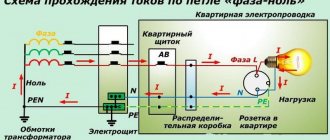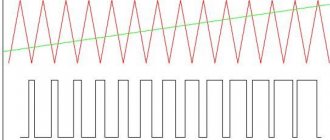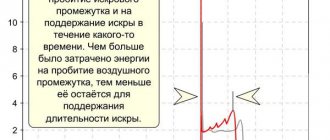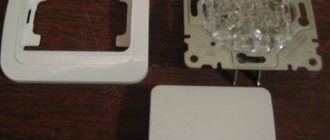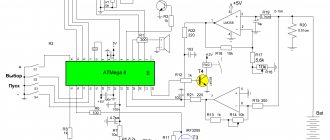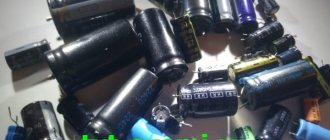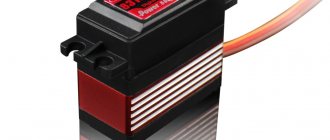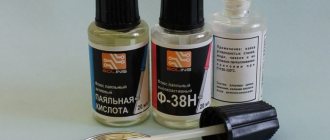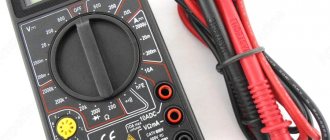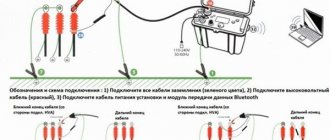What is a pyrometer?
A modern engineering device for determining the temperature of any object, based on an infrared sensor, is called a pyrometer. It is also known as a temperature detector, temperature data logger, digital thermometer or infrared gun. The operation of the device is based on the principle of determining the temperature value of the surface of an object from the thermal electromagnetic radiation of its surface. The pyrometer detects invisible infrared radiation, converts it into degrees, and displays the result on the display. A non-contact and quick method of examining necessary objects allows specialists to avoid possible injuries.
Pyrometer design
A pyrometer determines the temperature of an object by studying the radiation from its surface. Therefore, the most important part of the device is the infrared study detector. The detector records the intensity and spectrum of radiation.
Next, the built-in electronics save the collected data and convert it into degrees. The finished result is displayed on the screen. The pyrometer itself usually looks like a pistol.
Diagram - pyrometer design
There must be an LCD display, a small control panel and a laser “pointer” that is pointed at the measurement object. The body is compact.
When purchasing a pyrometer, pay attention to the following technical characteristics:
- optical resolution;
- temperature Range;
- permission;
- measurement speed (usually takes less than a second).
More expensive models may have built-in:
- memory for saving previous measurements;
- a sound signal notifying about the maximum or minimum temperature;
- USB connector.
The appearance and functionality of pyrometers will differ depending on their purpose.
Application area
Pyrometers have found quite wide application in those industries where a large number of heating devices are installed. In the field of construction and thermal power engineering, they are used to calculate the heat loss of structures, including a pyrometer that helps to identify damage to thermal insulation.
In industry, such devices make it possible to analyze the temperature of various processes remotely. This is necessary, for example, in mechanical engineering, metallurgy and other industries.
Thus, electricians check the heating level of wire connections, and car mechanics check the heating of car parts. Pyrometers come to the aid of scientists during various studies or experiments: this is how they determine the accuracy of the temperature of substances and bodies.
In everyday life, people use such devices to determine body temperature, water, food, etc.
Spectral ratio pyrometers
Spectral ratio pyrometers determine the temperature of an object by the ratio of signals from two receivers operating at different wavelengths. This principle of temperature measurement allows you to get rid of most of the disadvantages inherent in brightness pyrometers. The signal versus distance relationship is the same for both spectral ratio pyrometer receivers, so it does not affect the signal ratio. The shape of the measured object, dust and gas contamination of the intermediate medium equally affect the signals from both receivers, leaving their ratio unchanged. Spectral ratio pyrometers are insensitive to lateral illumination from large-sized objects, the presence of small opaque objects in the field of view of the pyrometer, and the presence of protective glass, for example, glass viewing windows in vacuum chambers. The signal ratio still remains the same. And a difference in the emissivity value of the measured object from 1 most often leads to an equal decrease in the signals from both receivers. Therefore, the signal ratio weakly depends on the emissivity of the object. It is necessary to note two main disadvantages of spectral ratio pyrometers. Firstly, the spectral ratio pyrometer is more complex than the radiation ratio one, a priori consists of a larger number of elements, and is more difficult to calibrate. Therefore, the cost of such pyrometers is higher than monochromatic ones. Secondly, what is the emissivity of the measured object? influences the measurement results. More precisely, the result of a spectral ratio pyrometer measurement depends not so much on the magnitude of the emissivity or on its change from object to object, but on the spectral dependence of the emissivity on the wavelength. As the wavelength increases, the spectral emissivity decreases. This leads to the fact that the signal from the long-wave receiver of the spectral ratio pyrometer is underestimated compared to the short-wave one. For this reason, the spectral ratio pyrometer readings are often overestimated by more than 10%. Some modern spectral ratio pyrometers use a special technique to automatically correct for the effects of changes in emissivity with wavelength. For a number of materials, including high-alloy steels, the dependence of the emissivity on wavelength was studied and a universal correction curve was selected, suitable for both pure iron and high-alloy steels, and for a number of other metals (nickel, cobalt, etc.). Moreover, for most of these metals, correction is possible to a level at which the measurement error in the temperature range from 600 to 2400°C is only 1–1.5% (for cobalt, up to 2%). This correction method not only preserves all the advantages that spectral ratio pyrometers have, but also relieves the user of the need to enter into the device a correction factor, the value of which is unknown to him, and replaces mechanical adjustment. Therefore, temperature measurements of many metals are carried out without increasing the error over the entire range of measured temperatures. (Source: A. Frunze “Spectral ratio pyrometers: advantages, disadvantages and ways to eliminate them,” PHOTONICS 4/2009) The use of three spectra also makes it possible to significantly reduce the dependence of the measurement error on changes in the emissivity value and on changes in the ε1/ε2 ratio. (source: Sergeev S.S. “Increasing the accuracy of temperature measurements using new models of pyrometers, website www.technoac.ru)
Types and classification
Depending on the functional characteristics, there are several classifications of pyrometers.
According to the essential method used in the work:
- Infrared;
- Optical.
Optical pyrometers are divided into:
- Brightness;
- Color, or multispectral.
Depending on the aiming method, devices with optical or laser sights are distinguished.
Based on the emissivity used, pyrometers with variable and fixed coefficients are distinguished.
Depending on the possibility of transportation, pyrometers are divided into stationary and mobile (portable).
Features of pyrometer operation
The distance between the device and the object whose temperature is measured does not affect the accuracy of the readings. However, the device must be used within the range specified by the manufacturer. In addition, the greater the distance between the device and the object, the larger the area probed.
Some pyrometers have two-position triggers. In the first position, the trigger stops halfway, and this position serves to scan the surface or area where there is heating inhomogeneity. In this position, the display changes depending on the number of irregular areas detected. This position is used to determine the approximate temperature of objects. The second position of the trigger mechanism is when the hook is completely recessed. This position is used to detect the object with the highest temperature if there are multiple objects. When the hook is in this position, the display will stop changing as soon as the highest temperature object is detected. This position is called the “highest reading hold position.”
Another feature of pyrometers is the presence of an emissivity switch. The emissivity switch compensates for reflected radiation that can affect the accuracy of temperature readings. Objects reflect infrared radiation coming from objects other than their own infrared radiation. However, reflected infrared radiation is not an indicator of the true temperature of an object, and a non-contact thermometer cannot distinguish emitted waves from reflected ones unless you adjust the emissivity switch to the object whose temperature is being measured. Most pyrometer manufacturers supply tables with the device that indicate the emissivity coefficients for the most commonly measured surfaces.
Device and principle of operation
The basis of the pyrometer structure is an infrared radiation detector. The data is converted via a built-in electronic system and displayed on the display.
A typical pyrometer is shaped like a pistol with a small display. The compact control panel, laser guidance and high accuracy during close interaction with the object explain the demand for the tool among workers in the engineering and technical fields.
The main working elements of a pyrometer are the lens, the receiver, and the display on which the measurement result is displayed. The principle of operation of the pyrometer is as follows: infrared radiation emanates from the object being studied and, through a lens, it is focused and sent to the receiver (thermopile, semiconductor, thermocouple).
If a thermocouple is used, the voltage changes when the receiver heats up. Resistance - in the case of using semiconductors. These changes are converted into temperature readings.
In order to take a measurement, you simply need to point the pyrometer at the object, activate it and note the result obtained. Using a special button, you can adjust the temperature measurement format - Celsius or Fahrenheit.
Optical pyrometers. Device. Operating principle.
An optical pyrometer is a device designed to measure the brightness temperatures of luminous bodies in one narrow wavelength range of the visible spectrum - determining the intensity of red monochromatic radiation. This is a hand-operated device, with the observer's eye serving as the sensitive element. Therefore, the device is suitable only for periodic, temporary observations, for example, when setting up a combustion process. The most common is an optical pyrometer with a “disappearing” filament. Its circuit diagram is shown in Fig. 2.2. Image of an object using a lens 2
is projected in the plane of the filament of the pyrometric lamp (reference).
The observer, examining the image of the thread using the eyepiece lens 6
, sees it against the background of the image of the heated body.
Absorbing glass is inserted between the pyrometric lamp and the lens as needed, and a light filter is inserted between the lamp and the observer’s eye. By changing the filament current of the pyrometric lamp, its brightness is achieved to match the brightness of the heated product. Then the observer’s eye will cease to distinguish the thread against the background of the image of the object and it, as they say, will “disappear.”
A simplified diagram of an optical pyrometer (OPPIR type) is shown in Fig. 2.3, a
.
The device consists of an optical system and a milliammeter 1
with a scale graduated in °C for different brightness temperature measurement limits.
The telescope has a lens 2
and an eyepiece
5
, with the help of which it is aimed at the measurement object.
3
is placed between the lens and the pyrometric lamp and a red
filter 6
.
The filament of a lamp is visible in the field observed through a telescope. The lamp is powered by current from battery B
.
The filament current is regulated by rheostat R
and measured by an indicating device
Rice. 2.2. Optical system of brightness visual pyrometer: 1
– sighted object;
2 –
pyrometer lens;
3 –
input diaphragm;
4 –
absorbing glass;
5 –
filament of a pyrometric lamp;
6 –
eyepiece lens;
7 – red filter; 8 –
output diaphragm
To measure body temperature, the pyrometer telescope is pointed at its radiating surface with the rheostat inserted. In this case, the lamp filament has a slight glow and is observed in the form of a black line (arc) on a light background, as shown in Fig. 2.3, b
.
| Rice. 2.3. Simplified diagram of the optical pyrometer OPPIR: a – diagram of the pyrometer; b , c , d – view of the thread observed through a telescope |
As the resistance of the rheostat decreases, the current increases, the pyrometric lamp heats up, and at the moment the brightness of the filament and the object of observation coincide, the incandescent part of the filament “disappears” against the background of the heated object (Fig. 2.3, c
).
At this moment, the instrument needle is set to the scale division corresponding to the measured brightness temperature. With a further increase in the lamp intensity, the filament will look like a light line on a dark background (Fig. 2.3, d
).
Knowing the dependence of the brightness temperature of the lamp filament on the filament current for a given device and measuring the current value at the moment the filament disappears, the brightness temperature of the object is determined.
Determining brightness temperatures using Planck's or Wien's spectral formulas requires measuring the brightness of bodies in the narrowest possible part of the spectrum. There are installations equipped with complex spectral equipment that make it possible to measure the brightness of bodies in very narrow spectral intervals. The applicability of such installations is currently limited only to laboratory conditions. Therefore, in widely used optical pyrometers, glass filters are used to monochromatize light. The most widely used is red glass KS-15 with a thickness of 2 mm.
In Fig. 2.4 are presented:
– a graph of the transmission of such glass for various wavelengths (in fact, only the region with a wavelength λ>0.62 μm is transmitted);
– relative sensitivity curve of the human eye (the greatest efficiency of vision in the center, for λ = 0.5-0.6 µm).
| Rice. 2.4. Curves of spectral sensitivity of the human eye (1) and transmission of a red light filter (2) |
When viewing through red glass, the human eye perceives the brightness of an object in a relatively narrow region of the spectrum (area abc).
The use of the red region of the spectrum in optical instruments makes it possible to lower the temperature limit of applicability of a pyrometer with a disappearing filament. To facilitate aiming and focusing when the object is low brightness, red glass can be removed from the field of view, but when equalizing brightness, a filter must be included in the optical design of the device.
A change in the temperature of the red light filter itself leads to a shift in the limit of its transmission, which causes a deviation in the effective wavelength at which the measurement is carried out, and, accordingly, to the appearance of an additional error.
| Rice. 2.5. Optical precision pyrometer | Rice. 2.6. Industrial optical pyrometer |
In Fig. Figure 2.5 shows a domestic precision optical pyrometer with a disappearing filament type image intensifier tube, which is used both for reference work on reproducing the temperature scale, and for temperature measurements in various scientific research. The device has a high aperture ratio (1:3) and due to this can be used to measure brightness temperatures in the red region of the spectrum starting from 800°C. In Fig. Figure 2.6 shows a portable industrial optical pyrometer of the OPPIR type. Devices of this type use a built-in measuring device (voltmeter).
Specifications
The pyrometer has a number of parameters that characterize its functionality. The choice of the desired device model is carried out according to their values. Let's look at the main ones.
Optical resolution
This is the name given to the ratio of the diameter of the tool spot to the distance to the object. This function depends on the angle of the device’s lens: the larger it is, the larger the area it can cover. The most important factor in the accuracy of the measurement is the application of the spot exclusively to the surface material. If the area is exceeded, the measured value will likely be inaccurate.
REFERENCE. Each pyrometer model has a different optical resolution. The difference between them is impressive, for example, from 2:1 to 600:1. The last ratio is typical for professional devices. As a rule, they are used in heavy industry. The optimal ratio for household and semi-professional pyrometers is 10:1.
Operating range
The operating range of the device depends on the pyrometric sensor and often varies from -30 °C to 360 °C. Thus, almost all types of pyrometers are suitable for domestic use, if we take into account the maximum temperature of the coolant in the heating system up to 110 °C.
Rating of laser non-contact pyrometers 2021
To understand which pyrometer is best to buy for your home, you should read the review of popular models. The most popular among buyers are non-contact devices with a laser sight.
ADA TemPro 700 A00224
A relatively inexpensive device from the professional category is suitable for detecting heat leaks in the house. Supplied in a durable case with a long handle, it is resistant to temperature changes and is characterized by highly reliable results. Equipped with a laser sight that allows you to take pinpoint readings.
Pyrometer ADA TemPro 700 can be purchased for 3,500 rubles
Testo 830-T1
The device is suitable for measuring low and high temperatures, and works not only with solid objects, but also with liquids. Thanks to the built-in laser, it can take readings from both large areas and small areas. Capable of taking measurements in the range from - 30 to + 400 °C.
Price Testo 830-T1 starts from 4000 rubles
Bosch PTD 1
The universal device determines the air and surface temperature, as well as the humidity level in the room. Used for technical purposes, helps identify heat leaks. Takes measurements from -20 to 200 °C on the surface, and as a room thermometer displays readings from -10 to 40 °C.
Reliable Bosch PTD 1 costs an average of 8,000 rubles
Advantages and disadvantages
Like any other device, a pyrometer has its advantages and disadvantages. Their presence is explained by the nuances of the device and the conditions of use.
pros
- Mobility, small size and very simple design;
- Affordable low cost due to the use of a minimum number of elements in the design;
- High level of reliability;
- Quite a wide measurement range.
Minuses
- Direct dependence of the pyrometer readings on the emissivity of the object under study;
- The accuracy of measurement results may be lower due to the physical state of the object's surface;
- The function of making corrections to indicators and establishing errors is provided only on the newest devices;
- Distance plays a big role in measurement accuracy.
Most popular models
EOP-66
The EOP-66 pyrometer is used in scientific and laboratory research. It is designed to measure the surfaces of objects at temperatures from +900 to +10000°C,
This stationary model is equipped with a telescope, which consists of a lens and an eyepiece microscope. The two-element lens has the ability to focus at a distance of up to 25.4 cm, and its optical resolution is 3:1. Please note: the telescope of this device is fixed on the base and moves smoothly in the horizontal plane.
Kelvin X 4-20
This is a high-precision pyrometer, which has a universal range for determining temperature indicators: from -50 to +350 ° C, a very high speed of action - 0.2 s. The instrument can be used in the range of 8-14 microns.
This pyrometer combines the capabilities of both a mobile and stationary device. This is due to its compact dimensions (17x17x22 cm) and the presence of an M12 lens mount. The manufacturer guarantees absolute water and dust resistance. Thus, the presented pyrometer model can be used in complex manufacturing and construction industries.
How to choose the right pyrometer
The choice of device depends primarily on where and for what purposes it will be used. Some models are better for measuring body temperature, while others are designed for culinary purposes.
Which pyrometer to choose for your home
The most popular in home use are portable infrared devices. A stationary device operating from the network is unlikely to be useful for domestic purposes, despite its high accuracy. When choosing a pyrometer for your home, you need to consider:
- temperature range, in everyday life there will be a sufficient range from - 50 to 380 ° C;
- accuracy, the error of the device should be no more than 3 degrees;
- range - pyrometers can be contact or non-contact; when using the latter, you need to take into account the optical resolution, or the required distance to the object;
- speed, in everyday life it is convenient to use devices with a response from 0.1 to 0.15 seconds.
Also, when comparing pyrometers and choosing the best one, you can take into account additional parameters. Some models can measure humidity. It is useful if the device is able to save the results of tests performed in the built-in memory.
Which pyrometer is better to choose for a pastry chef?
When choosing a pyrometer for baking in a workshop or at home, you can buy a non-contact device with a range from - 50 to + 400 °C. But models with a thermocouple perform best in cooking; they are connected to the main unit and measurements are taken using the contact method to obtain the most accurate results. Then the test is repeated remotely to compare the indicators; the difference usually reaches several degrees.
In cooking, contact pyrometers with a thermocouple remain the best
How to choose a medical pyrometer
Medical devices are often used instead of conventional thermometers. You need to select a device according to the following parameters:
- contact or non-contact action, devices of the first type are more accurate, although the second can be used for several people without disinfection;
- accuracy, for a medical pyrometer the minimum error is important;
- functionality, it is useful if the device is equipped with a sound signal and can indicate the completion of the measurement.
Important! The medical device does not require a large temperature range.
How to choose a non-contact infrared pyrometer
The best pyrometers for measuring temperature using a non-contact method are very popular in everyday life. Such devices demonstrate high accuracy and are versatile. They can also measure very hot, dangerous or hard-to-reach objects.
When choosing, you need to look at several characteristics:
- Range. If you only need to determine body temperature and weak thermal radiation from surfaces, you can choose a device with small values. For culinary use, you need to buy a model with a wide range, and it is desirable that even very high temperatures are kept away from the maximum possible readings of the device.
- Spectral sensitivity. It is better to choose a device that operates on short waves; it is suitable for most household measurements.
- Chroma. Usually, single-color pyrometers are sufficient for home use. Two-color models should be chosen if you need to evaluate the temperature of very small and hot objects, as well as objects whose radiation is partially blocked by any contamination or obstacles.
When choosing a home pyrometer, first of all, you need to evaluate its thermal range.
Infrared devices equipped with a laser sight are considered the best. They help measure the temperature of an object at a specific selected point and thus reduce the likely error.
How to choose a pyrometer for measuring temperature
If the device is to be used instead of a thermometer, first of all you need to decide on its type - contact or non-contact. Devices from the last category are recommended for young children. But for adults and teenagers it is better to use contact pyrometers - frontal or ear. They give more accurate readings and are almost as good as mercury thermometers.
